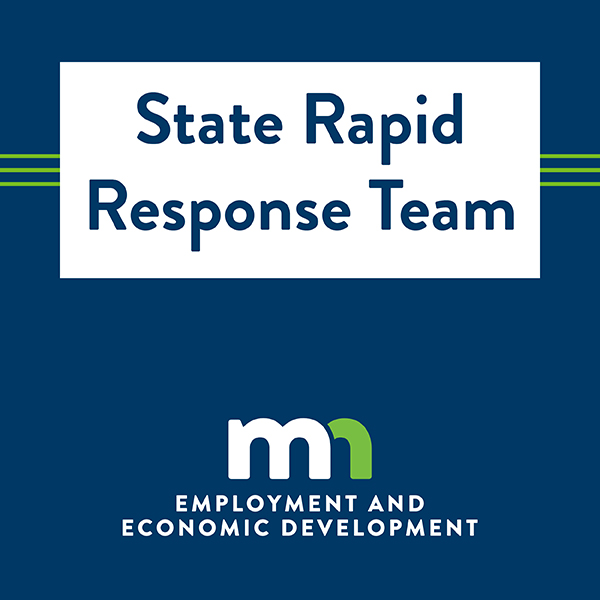Layoff and Business Closure Resources

Rapid Response Services
Rapid Response is a pro-active, business-focused, and flexible strategy designed to respond to layoffs and plant closings by quickly coordinating services and providing immediate aid to companies and their affected workers. Rapid Response teams will work with employers and any employee representative(s) to quickly maximize public and private resources to minimize disruptions associated with job loss. Rapid Response can provide customized services for an affected company, accommodate any work schedules, and assist companies and workers through the painful transitions associated with job loss including virtual services as needed.
Rapid Response is carried out by states and local workforce development agencies in partnership with local One Stop Centers. Many services from resume and interview workshops, career counseling, and job search to re-skilling, skills upgrading, and job training.
WorkforceGPS Rapid Response Fact Sheet (download DOCX)
Rapid Response Serves
- Rapid Response for Laid-Off Workers who have been displaced. Access a comprehensive range of direct services, benefits, training opportunities, and income support.
- Rapid Response Services to Employers. Avoid future layoffs, access incumbent worker training programs and skilled job seekers, and become familiar with employment rights and regulations such as the WARN Act, administered by the DOL.
-

For Employers Considering a Layoff
If you're considering a major layoff or plant closing, we can help guide you through what will be a difficult process for your company and a difficult time for your employees. We can help you comply with federal regulations that apply to mass layoffs, bring a variety of services for your employees straight to your workplace, and even propose some useful alternatives.
Bankruptcy Notification
Under Minnesota law, employers must notify employees and job applicants that the company has filed a petition for bankruptcy or has had an involuntary bankruptcy petition filed against it. Failure to provide the required notice is a misdemeanor.
Learn More
Consultants at our Small Business Assistance Office can help you understand more about all the factors you'll need to know about bankruptcy. And our network of Small Business Development Centers has experts located in nine main regional offices and several satellite centers statewide.
Our Guide to Starting a Business in Minnesota covers this and An Employer's Guide to Employment Law Issues in Minnesota provide a deeper look at this and other issues that commonly arise in the workplace.
Dislocated Worker Program
Federal law requires employers with at least 100 employees to notify us at the Minnesota Department of Employment and Economic Development at least 60 days prior to a mass layoff or plant closing.
After an initial meeting with you -- and with your permission -- our Rapid Response Team will bring professional staff and services right to your workplace. The sooner our team can be in place, the better prepared your employees will be to find new jobs.
Overview
State Rapid Response Team (SRRT) Process
The SRRT employs a comprehensive four-step process that is both time-tested and straightforward, ensuring ease of use and clarity for all stakeholders. Here is an overview of how our team will collaborate with you.
Step One: Initial On-site Employer Meeting
We meet with management and union leaders (if applicable) either in person or virtually to determine layoff details, explore layoff aversion options and explain our programs.
Step Two: Informational Meetings with Workers
Meetings occur at the work site or online. We offer an overview of services and survey the needs of the workforce. We will form a Planning and Selection Committee if there are 50 or more employees interested in the Dislocated Worker program. The committee members include company management, employees, and union leaders. We will provide information on resources available including unemployment insurance, CareerForce job search assistance and MNsure.
Step Three: Planning and Selection Committee (PSC) Meets
Under the facilitation of our team and company cooperation, the committee identifies worker needs and match those with services offered by the Dislocated Worker program. Committees generally meet twice. The committee will select a Dislocated Worker program service provider that best matches the needs of the workforce.
Step Four: PSC and Provider Refine a Grant Proposal
Services to workers can begin quickly, often within 24 hours of the PSC’s final meeting. While services are underway, the PSC and the service provider will collaborate on a grant application to the state. The grant will ensure all workers are able to access the needed services. Services are provided by the chosen service provider and could include onsite enrollment sessions, recruitment events, resource fairs and more.
-
 SRRT Natural and Other Disaster Assistance
SRRT Natural and Other Disaster AssistanceNatural disasters are covered under the Governor's Executive Order which assigns emergency responsibilities to State agencies. Each agency has an Emergency Operations Plan that details their responsibilities and roles in coordinating with other state and federal agencies, as deemed necessary by the disaster event and declaration by the President to engage FEMA. The following is a high level description of the role DEED plays in a disaster response:
- The primary objective of Minnesota's State Rapid Response Team (SRRT) is to proactively mitigate layoffs when feasible, minimize their impact on affected workers, and expedite the transition of dislocated workers to new employment opportunities. SRRT interventions address various scenarios, including business closures, mass layoffs (involving 50 or more workers), small layoffs (involving fewer than 50 employees), and layoffs resulting from both manmade and natural disasters.
Minnesota's State Rapid Response Team (SRRT) procedures for addressing natural or manmade disasters are designed to mitigate adverse economic and community impacts resulting from actual or imminent crises. These protocols emphasize maintaining effective communication, close coordination, and establishing strategic partnerships with key entities, including Minnesota Homeland Security and Emergency Management (HSEM) and FEMA when necessary.
In the event of a disaster, the SRRT leverages its partnerships with emergency management organizations (such as HSEM and FEMA), Chief Elected Officials (CEOs), local Chambers of Commerce, Economic Development Associations (EDAs), labor and industry organizations, and the U.S. Department of Labor (U.S. DOL) to stay informed and provide timely assistance to affected areas and workers. Additionally, collaborations with Minnesota's CareerForce locations and Local Workforce Development Boards (LWDB) enhance the team's capabilities.
The SRRT serves as a key convener in planning the state's disaster response and plays a crucial role in delivering reemployment and transition services to those impacted by disasters. The team ensures that the Minnesota Department of Employment and Economic Development (DEED) website and CareerForceMN are updated with essential information as needed.
These preparations, combined with flexibility and creativity in responding to unexpected events, enable the SRRT to quickly and effectively manage major events, providing critical support to communities, employers, and their employees.
- Disaster Unemployment Assistance (DUA): DUA helps unemployed workers and self-employed individuals who are unable to work as a direct result of a major disaster, and if the individual is not eligible for other unemployment insurance benefits. DUA is administered by the Unemployment Insurance Division. For DEED to initiate DUA, the President must issue a disaster declaration providing for individual assistance. Individuals can apply for unemployment insurance benefits or contact 877-898-9090.
- Temporary CareerForce locations:
- If a disaster strikes a community and a DEED CareerForce location is not available within close proximity, a temporary center may be opened. Services provided at the location would be for answering questions related to Disaster Unemployment Insurance, Dislocated Worker Services and the National Dislocated Worker Grant temporary employment. The logistics of a temporary center being opened would be handled in conjunction with Administrative and Financial Services' Facilities Coordinator.
- Provide materials or representation at Disaster Recovery Centers (DRCs) and public meetings, as requested by the Division of Homeland Security and Emergency Management, to furnish information relative to disaster unemployment, dislocated worker, job training and applicable programs.
- In the event of a natural disaster, where federal assistance is needed to supplement local efforts, National Dislocated Worker Grants (DWG) are awarded to states by the USDOL to temporarily expand the service capacity of the DW program by providing funding assistance in response to large, unexpected economic events with significant job loss. Minnesota has been awarded two National Dislocated Worker Grants.
National Dislocated Worker Grant (DWG) A DWG creates temporary employment to assist with clean-up on public land and infrastructure resulting from a natural disaster. Work under the NDWG program is administered by the Employment and Training Programs Dislocated Worker Unit. For DEED to initiate a DWG application, the President must declare a major disaster for public assistance. A NDWG is issued by the U.S. Department of Labor, lasts six months, and can provide up to $12,000 to each eligible individual in wages. After a NDWG is awarded to DEED, Job Seeker Services sub-grants the funding to a local level project operator to implement activity within counties that had been designated by FEMA for public assistance. Individuals interested in employment through the NDWG would obtain information through their local CareerForce location.
States may qualify for a National Dislocated Worker Grant under WIOA law. There are two types and purposes of National Dislocated Worker Grants (DWGs) under sec. 170 of WIOA: Employment Recovery DWGs and Disaster Recovery DWGs.
Applications for Employment Recovery DWGs may be submitted at any time during the year and must be submitted to respond to eligible events as soon as possible when:
- The applicant receives a notification of a mass layoff or a closure as a result of a Worker Adjustment and Retraining Notification (WARN) Act notice, a general announcement, or some other means, or in the case of applications to address situations described in CFR 687.110(a)(4), when higher-than-average demand for employment and training activities for those members of the Armed Forces and military spouses exceeds State and local resources for providing such activities;
- Worker needs and interest in services has been determined through Rapid Response, or other means, and is sufficient to justify the need for a DWG; and
- A determination has been made, in collaboration with the applicable local area, that State and local formula funds are inadequate to provide the level of services needed by the affected workers.
- Applications for Disaster Recovery DWGs to respond to an emergency or major disaster must be submitted as soon as possible when:
- As described in CFR 687.110(b)(1), FEMA has declared that the affected area is eligible for public assistance;
- A situation as described in CFR 687.110(b)(2) occurs. The applications must indicate the applicable Federal agency declaration, describe the impact on the local and/or State economy, and describe the proposed activities; or
- A situation as described in CFR 687.110(b)(3) occurs, and interest in services has been determined and is sufficient to justify the need for a DWG.
-
 Plant closures and significant layoffs can result from various factors such as financial constraints, mergers and acquisitions, market loss, consolidations, international competition, product, or service obsolescence, or shifts in parent company focus. Once a company announces plans to close or downsize significantly, the decision is often seen as final and irreversible. However, there may be opportunities to reconsider and explore alternatives for job retention and layoff mitigation.
Plant closures and significant layoffs can result from various factors such as financial constraints, mergers and acquisitions, market loss, consolidations, international competition, product, or service obsolescence, or shifts in parent company focus. Once a company announces plans to close or downsize significantly, the decision is often seen as final and irreversible. However, there may be opportunities to reconsider and explore alternatives for job retention and layoff mitigation.The SRRT collaborates with organizations to identify and evaluate potential strategies and programs which may help prevent layoffs and reduce the impact of job losses on businesses, employees, and the community.
Available programs (include but may not be limited to)
Shared Work Program
Selected employees will work reduced hours during a temporary slowdown. They receive unemployment benefits to offset their reduced wages.
- Keep experienced and trained staff.
- Avoid future hiring and training costs.
- Increase operations quickly when business conditions improve.
- Avoid a layoff which creates goodwill and financial stability for the workforce and community.
Learn more about the Shared Work Program.
We are here to help! If you have questions, email shared.work@state.mn.us.
On-the-Job Training (OJT)
Hire and train skilled workers and get reimbursed for your efforts. you'll benefit from more efficient recruiting, more targeted training, and assistance with training expenses.
- OJT specialists help you find the right talent when you need it, reducing time, effort, and money spent on recruiting.
- The technical skills you need may be hard to find. OJT helps you train workers to meet your requirements.
- You receive up to 50% of the costs to provide on-the-job training for individuals you hire through the public workforce system.
Incumbent Worker Program
Training designed to meet the needs of an employer (or group of employers) to retain a skilled workforce or avert the need to lay off by helping workers obtain the skills necessary to retain employment and the competitiveness of the employee and/or employer.
- Provides marketable expertise to employees.
- Builds and maintains a quality workforce.
- Retains a skilled workforce and/or avert layoffs.
Layoff Aversion Resources
-
 The Worker Adjustment and Retraining Notification (WARN) Act is a federal law that was enacted on August 4, 1988, and became effective on February 4, 1989.
The Worker Adjustment and Retraining Notification (WARN) Act is a federal law that was enacted on August 4, 1988, and became effective on February 4, 1989.Minnesota enacted their own WARN statute (116L.976 EARLY WARNING SYSTEM - Minn. Stat. 116L.976), commonly called a mini-WARN Act, which is in addition to any notice required under the federal WARN Act.
The purpose of a WARN is to offer protection to workers, their families and communities by requiring employers to provide notice 60 days in advance of covered plant closings and covered mass layoffs. This allows those workers, local communities and public resources to make provisions for dealing with the layoffs. In rare occurrences we do receive WARNS from employers that would not be required to comply, as more of a courtesy.
Employers laying off workers employed in Minnesota should be aware that federal and/or state law may require that written notice be provided 60 days in advance of a dislocation event. Employers must comply with both laws if they both apply.
Violation of the federal and/or state notice laws may result in employer liability. The WARN Act contains provisions that allow aggrieved employees to recover up to 60 days of back pay and benefits for the period of time that notice was required but not provided. Additional monetary penalties may be assessed if the employer fails to provide timely notice to the required unit of local government.
Employers are encouraged to voluntarily provide advance notice to workers, even when not mandated by the WARN Act or Minnesota's Mini-WARN/state statute, and to collaborate with the State Rapid Response Team (SRRT). This partnership can assist employers with layoffs or closures and support employees in accessing programs that facilitate their transition to new employment opportunities.
If requesting WARN data, please submit data requests and inquiries to DEED's data practices compliance official at DEED.datapractices@state.mn.us. We process data requests in order of receipt.
WARN Act Basics/Compliance
What employers are subject to the WARN Act?
The WARN Act applies to any business enterprise that employs either:
- 100 or more employees, excluding part-time employees; or
- 100 or more employees who in the aggregate work at least 4,000 hours per week (exclusive of overtime hours).
What is a "plant closing"?
A "plant closing" is defined as "the permanent or temporary shutdown of a single site of employment, or one or more facilities or operating units within a single site of employment, if the shutdown results in an employment loss at the single site of employment during any 30-day period for 50 or more employees excluding any part-time employees."
What is a "mass layoff"?
A "mass layoff" is defined as a reduction in force that: (1) is not the result of a plant closing; and (2) results in an employment loss at the single site of employment during any 30-day period for either:
- At least 33% of the employees (excluding any part-time employees) and at least 50 employees (excluding any part-time employees); or
- At least 500 employees (excluding any part-time employees).
Exceptions to WARN
There are certain situations in which a covered employer may order a plant closing or mass layoff before the end of the 60-day notice period required under the WARN Act. These situations include the following:
- If, at the time that the 60-day notice would have been required, the employer was actively seeking capital or business which, if obtained, would have enable the employer to avoid or postpone the shutdown and the employer reasonably and in good faith believed that giving the 60-day notice would have precluded the employer from obtaining the needed capital or business;
- If the closing or mass layoff is caused by business circumstances that were not reasonably foreseeable as of the time that the 60-day notice would have been required; or
- If the plant closing or mass layoff is due to any form of natural disaster, such as a flood, earthquake, or a severe drought.
If any of these exceptions apply, the employer must give "as much notice as is practicable," and the employer must include in the notice "a brief statement of the basis for reducing the notification period."
In addition, the WARN Act does not apply to a plant closing or mass layoff if:
- The closing is of a temporary facility, or the closing or layoff is the result of the completion of a particular project or undertaking, and the affected employees were hired with the understanding that their employment was limited to the duration of the facility or the project or undertaking; or
- The closing or layoff constitutes a strike or constitutes a lockout not intended to evade the requirements of the WARN Act.
What information to include in WARN to employees?
The WARN Act requires that covered employers generally must provide at least 60 days notice to affected employees or their representatives before ordering a "plant closing" or "mass layoff," unless certain exceptions are applicable
What information must be in the notice depends on whether the affected employees are represented by a union?
If the affected employees are not represented by a union, the notice must be written in understandable language and must contain:
- A statement as to whether the planned action is expected to be permanent or temporary and, if the entire plant is to be closed, a statement to that effect;
- The expected date when the plant closing or mass layoff will commence and the expected date when the individual employee will be separated;
- An indication whether bumping rights exist; and
- The name and telephone number of a company official to contact for further information.
If the affected employees are represented by a union, the notice to the union representative must contain:
- The name and address of the employment site where the plant closing or mass layoff will occur, and the name and telephone number of a company official to contact for further information;
- A statement as to whether the planned action is expected to be permanent or temporary and, if the entire plant is to be closed, a statement to that effect;
- The expected date of the first separation and the anticipated schedule for making separations;
- The job titles of positions to be affected and the names of the workers currently holding affected jobs
In either case, the notice may include additional information useful to the employees such as information on available dislocated worker assistance, or, if the layoff or closing is expected to be temporary, the estimated duration of the layoff or closing, if known.
WARN Act Resources
- U.S. Department of Labor WARN Act Compliance Assistance
- U.S. Department of Labor WARN Frequently Asked Questions
- The U.S. Department of Labor's website contains links to several WARN Act resources, including a Fact Sheet, to help workers and employers understand their rights and responsibilities under the law
- The Worker Adjustment and Retraining Notification (WARN) Act, Public Law 100-379 (29 USC 2101 et seq.)
- The Federal Regulations, 20 CFR Part 639
- Minn. Stat. 116L.976 Early Warning System
- Sample WARN Letter
- Sample WARN Letter 2
- SRRT Worker List Template
WARN Contact
State Rapid Response Team (SRRT) Supervisor
For questions and issuances of notifications, please contact the State Rapid Response Supervisor at Minnesota Department of Employment and Economic Development (DEED) Location
Minnesota Department of Employment and Economic Development
Jason Wadell
Great Northern Building
180 East Fifth Street,
St Paul, MN 55101-1678Phone
651-259-7537 or
866-213-1422Email
Send the written notice to WARN.DEED@state.mn.us.
-
 Please note that the notice requirements under Minn. Stat. 116L.976 - Early Warning System shall be in addition to any notice required under the Worker Adjustment and Retraining Notification Act - 29 US Code 2101.
Please note that the notice requirements under Minn. Stat. 116L.976 - Early Warning System shall be in addition to any notice required under the Worker Adjustment and Retraining Notification Act - 29 US Code 2101.Although Minn. Stat. 116L.976 is similar to the federal WARN Act, there are some differences. The law encourages Minnesota businesses "considering a decision to effect a plant closing, substantial layoff, or relocation of operations...to give notice of that decision as early as possible to" the following:
- The Minnesota Commissioner of Employment and Economic Development;
- The employees of the affected establishment;
- Any employee organization representing the employees; and
- The local government unit in which the affected establishment is located.
This notice is in addition to any notice required under the federal WARN Act.
In addition, the law requires that any employer who provides notice of a plant closing, substantial layoff, or relocation of operations under the federal WARN Act or under Minnesota's Mini-WARN Act must report to the Minnesota Commissioner of Employment and Economic Development "the names, addresses, and occupations of the employees who will be or have been terminated."
For purposes of the Minn. Stat. 116L.976 EARLY WARNING SYSTEM/Mini-WARN Act:
"Plant closing" is defined to mean "the announced or actual permanent or temporary shutdown of a single site of employment, or one or more facilities or operating units within a single site of employment, if the shutdown results in an employment loss at the single site of employment during any 30-day period for 50 or more employees excluding employees who work less than 20 hours per week."
If requesting WARN data, please submit data requests and inquiries to DEED's data practices compliance official at DEED.datapractices@state.mn.us. We process data requests in order of receipt.
WARN Act Resources
- U.S. Department of Labor WARN Act Compliance Assistance
- U.S. Department of Labor WARN Frequently Asked Questions
- The U.S. Department of Labor's website contains links to several WARN Act resources, including a Fact Sheet, to help workers and employers understand their rights and responsibilities under the law.
- The Worker Adjustment and Retraining Notification (WARN) Act, Public Law 100-379 (29 USC 2101 et seq.).
- The Federal Regulations, 20 CFR Part 639.
- Minn. Stat. 116L.976 Early Warning System
- Sample WARN Letter
- Sample WARN Letter 2
- SRRT Worker List Template
WARN Contact
State Rapid Response Team (SRRT) Supervisor
For questions and issuances of notifications, please contact the State Rapid Response Supervisor at Minnesota Department of Employment and Economic Development (DEED) Location
Minnesota Department of Employment and Economic Development
Jason Wadell
Great Northern Building
180 East Fifth Street,
St Paul, MN 55101-1678Phone
651-259-7537 or
866-213-1422Email
Send the written notice to WARN.DEED@state.mn.us.
-
WARN notices received from Minnesota employers will be listed.
2026
- Wabash National Services LP - 1/5/26
2025
- Nilfisk Inc. - 12/10/25 Revised
- The Vollrath Company, LLC - 12/4/25
- EDS Service Solutions, LLC - 11/21/25
- Nordstrom - 11/20/25
- Dependable Home Healthcare - 11/3/25
- Cannon Equipment - 10/29/25
- Target - Brooklyn Park - 10/28/25
- Target - Minneapolis - 10/28/25
- Cargill - 10/27/25
- Equiniti Trust Company, LLC - 10/24/25
- OMG Midwest, Inc. d/b/a Minnesota Paving & Materials - 10/20/25
- Minnesota Star Tribune - 10/3/25
- Nilfisk Inc. - 9/26/25
- BLST Operating Company, LLC - Eden Prairie (2) - 9/17/25
- Illume Candles LLC - 9/16/25
- Centrex Rehab - 9/2/25
- BLST Operating Company, LLC - St. Cloud - 8/27/25
- BLST Operating Company, LLC - Eden Prairie - 8/27/25
- Bremer Bank (a Division of Old National Bank) - 8/22/25
- TransAxle, LLC - 8/21/25
- Zeco Systems, Inc. - 8/18/25
- BLST Operating Company - 8/13/25
- Smurfit Westrock - 8/12/25
- Equiniti Trust Company, LLC - 8/11/25
- Walmart (Coon Rapids) - 7/31/25
- SUPERVALU Inc and SUPERVALU Pharmacy (Cub - Midway) - 7/21/25
- S & R Quisberg, Inc. - 7/15/25
- J & E Companies - Lakeville - 6/2/25
- J & E Companies - Plymouth - 6/2/25
- J & E Companies - Shakopee - 6/2/25
- Equiniti Trust Company, LLC - 5/22/25
- CommonBond Communities - 5/19/25
- TransAxle, LLC - 5/16/2025
- Apple Valley Foods US - 5/13/25
- Fellers - 4/30/25
- Smurfit Westrock - 4/30/25
- Accelerate360 Distribution - 4/25/25
- IV Media - 4/17/25
- IV Media - 4/16/25
- Fortrex - 4/9/25
- Teleflex - 4/8/25
- North America Science Associates - 4/7/25
- Crecera Brands - 3/31/25
- Cleveland-Cliffs Hibbing - 3/20/25
- Cleveland-Cliffs Minorca - 3/20/25
- NUWAY Alliance - 2/28/25
- Veyer - 2/28/25
- Arctic Cat - 2/27/25
- The Shade Store - 2/27/25
- Upsher Smith - 2/27/25
- UPS - 2/21/25
- UPS - 2/12/25
- BLST Operating Company - 2/1/25
- Upsher-Smith - 2/6/25
- CNH Industrial America - 2/6/25
- IV Media - 1/29/25
- Green Plains - 1/15/25
- Digital River - 1/27/25
- Danfoss Power Solutions - 1/24/25
- Macy's Maplewood - 1/9/25
2024
- IV Media - 12/18/24
- McKesson Medical-Surgical Inc. - 12/13/24
- Cargill - 12/2/24
- Cygnus Home Service - 9/23/24
- ASM Global - 9/20/24
- Millennium - 9/4/24
- Fulfillment Distribution Center - 7/17/24
- Cygnus Home Service - 7/16/24
- ICU Medical - 7/16/24
- Equiniti Trust Company - 7/12/24
- BCS Access Business Systems U.S. - 7/11/24
- Rich Products Corporation - 7/11/24
- Charter Communications - 6/12/24
- Cygnus Home Service - 5/28/24
- BRP Marine US - 5/23/24
- Bay View Nursing and Rehabilitation Center - 5/22/24
- Nortech - 5/17/24
- Nortech - 5/16/24
- Major Metro - 5/7/24
- Copeland - 4/30/24
- Fulfillment Distribution Center - 4/23/24
- Aramark at General Mills - 3/29/24
- BCS Access Business Systems U.S. - 3/26/24
- Northern Foundry - 3/1/24
- Compass Group USA - 2/2/24
2023
- Marsden
- Ferring Pharmaceuticals - 12/6/23
- Northern Engraving
- Amerigroup Partnership Plan - 11/3/23
- Kent Precision Foods Group - 9/22/23
- Kent Precision Foods Group Foley - 9/22/23
- Alumacraft - 9/21/23
- WestRock - 9/13/23
- ICU Medical - 8/17/23
- TE Connectivity - 8/16/23
- Shutterfly - 8/10/23
- Yellow Corporation - 7/30/23
- Legrand AV - 5/25/23
- 3M - 5/1/23
- David's Bridal - 4/14/23
- Packers Sanitation Services - 4/10/23
- HyLife Foods - 4/10/23
- BLST Operating Company - 3/31/23
- Walmart - 3/23/23
- Target - 3/13/23
- Active Sports - 3/1/23
- Plastech - 2/13/23
- Bright Health Group - 1/31/23
- Amazon - 1/30/23
- Shutterfly - 1/26/23
Join our mail list to be notified of future WARN notices.
If you need documents older than three years or in an accessible format, please contact warn.deed@state.mn.us.
-
 Plant Closings/Mass Layoffs/Warn Summary Report
Plant Closings/Mass Layoffs/Warn Summary ReportEmployers with 50 employees or more are required by federal and state law to report large layoffs to the state Rapid Response Team.
Our reports identify events, number of workers affected and other relevant information pertaining to large layoffs.
Please submit data requests and inquiries to DEED's data practices compliance official at DEED.datapractices@state.mn.us. We process data requests in order of receipt.
Your written request should include:
- A statement that you, as a member of the public, are making a request for data under the Minnesota Government Data Practices Act, Minn. Stat. Chap. 13.
- Your preference as to whether you would like to inspect the data, receive physical copies of the data, or receive electronic copies of the data.
- A clear and specific description of the data you would like to inspect or have copied.
Join our mail list to be informed of upcoming layoffs. Click to subscribe.
2025
2024
2023
2022
Annual
-
 Handbooks
Handbooks- Laid Off? We Can Help - Mass Layoff Handbook (50+ impacted)
- Laid Off? We Can Help - Small Layoff Handbook (1 - 49 impacted)
Flyers
- Dislocated Worker Program Fact Sheet – Lose your job through no fault of your own? English
- Dislocated Worker Program Fact Sheet – Lose your job through no fault of your own? Union
- Dislocated Worker Program Fact Sheet – Lose your job through no fault of your own? Farmers
- Dislocated Worker Program Fact Sheet – Lose your job through no fault of your own? Amharic
- Dislocated Worker Program Fact Sheet – Lose your job through no fault of your own? Hmoob
- Dislocated Worker Program Fact Sheet – Lose your job through no fault of your own? Karen
- Dislocated Worker Program Fact Sheet – Lose your job through no fault of your own? Af-Soomaali
- Dislocated Worker Program Fact Sheet – Lose your job through no fault of your own? Español
Dislocated Worker Program Videos
-
 Join our mail list to be informed of upcoming layoffs. Click to subscribe.
Join our mail list to be informed of upcoming layoffs. Click to subscribe.
Jason Wadell
State Rapid Response Team, Supervisor
651-259-7552 or 866-213-1422Marla Beaty
SRRT Sr. Specialist/TAA Liaison
651-259-7531 or 866-213-1422Olajide Williams
SRRT Sr. Specialist
651-259-7431 or 866-213-1422Liz McLoone
SRRT Sr. Specialist/Labor Liaison
651-259-7145 or 866-213-1422
John Mohs
SRRT Sr. Specialist
651-259-7535 or 866-213-1422
Mee Yang
SRRT Sr. Specialist
651-259-7548 or 866-213-1422 -
 Policy
PolicyTraining and Employment Guidance Letters (TEGLs) and Training and Employment Notices (TENs)
- TEGL 4-20 Guidance on Integrating Services for Trade-Affected Workers under the Trade Adjustment Assistance Program (TAA Program) with the Workforce Innovation and Opportunity Act (WIOA) Title I Dislocated Worker (DW) Program
- TEGL 19-16 Guidance on Services provided through the Adult and Dislocated Worker Programs under the WIOA and the Wagner-Peyser Act Employment Service (ES), as amended by title III of WIOA, and for Implementation of the WIOA Final Rules
- TEGL 16-16 One-Stop Operations Guidance for the American Job Center Network
- TEN 23-14 How-To Guide for Completing a Petition for the Trade Adjustment Assistance (TAA) Program and Partnering with Rapid Response Teams to Improve the Quality of State-Filed Petitions
- TEN 31-11 The Rapid Response Framework
- TEN 32-11 Rapid Response Self-Assessment Tool
- TEN 9-12 Layoff Aversion in Rapid Response System

